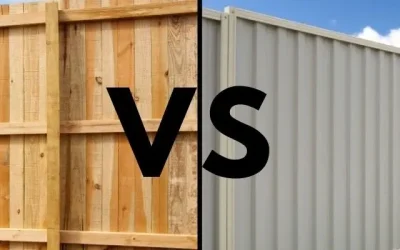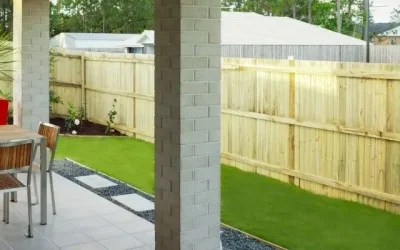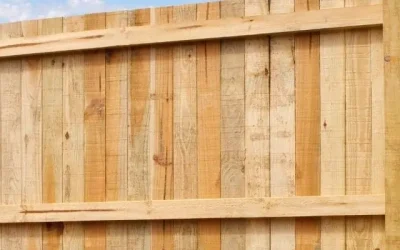Whether you’re in Melton or the western suburbs of Melbourne, your fence is constantly exposed to the elements, and when it’s not built or maintained properly, it’s one of the first things to show signs of wear and tear. A strong, well-installed fence provides many benefits for your property, but the natural elements can be tough even on the best fences, so it pays to know what can go wrong and what you can do to prevent it.
In this post, we’ll walk you through 5 of the most common causes of fence damage and share practical tips to keep your fence standing tall.
1. Strong Winds and Storms
Melbourne is no stranger to strong winds, especially in newer estates and open areas where there’s little to block gusts. Sudden storms, often in spring and summer, can bring damaging winds that put serious pressure on fences. If your fence isn’t built to handle it, panels can rattle loose, posts may lean or snap, and in some cases, the whole thing can come down in dramatic fashion.
This kind of damage is more common when fences haven’t been reinforced properly or built with lightweight materials. Older fences that have already started to weaken are even more at risk.
How to prevent it:
Start with strong posts set deep in concrete, at least 600mm to 900mm, depending on soil and fence height. Choose wind-smart designs like aluminium slat fencing or Colorbond with gaps beneath panels to reduce resistance.

2. Soil Movement
Much of Western Melbourne, including Melton, sits on reactive basaltic clay soil. This type of soil expands when it gets wet and shrinks when it dries out, which can cause the ground to shift beneath your fence. Over time, these movements put pressure on your fence posts, leading to leaning, cracking, or even sections pulling away from the ground. It’s one of those slow-moving issues that can catch homeowners off guard. The fence may have looked fine last season, but now it’s starting to tilt.
How to prevent it:
The best defence is proper footing depth and a strong, stable foundation. Posts should be set deep enough with quality concrete, and drainage should be managed so water doesn’t pool at the base.
3. Poor Installation
Not all fences are built the same, and unfortunately, we see the results of rushed, super low-cost jobs all the time across Western Melbourne. Posts that aren’t level, footings that are too shallow, insufficient concrete being used, or panels that haven’t been secured properly can all lead to early failure. If the work wasn’t done properly, gaps may open up, panels can sag, and in windy conditions, the whole structure becomes vulnerable.
How to prevent it:
Always hire experienced fencing contractors who know how to work with local soil, weather, and follow industry best practices. A quality installation takes time, attention to detail, and the right materials, but it saves you money and stress in the long run.

4. Corrosion and Rust
Metal fences like Colorbond, steel, or chain wire are popular for their durability, but even these can start to break down over time, especially in areas that hold moisture. In lower-lying parts of Western Melbourne or places with poor drainage, water can pool around fence posts and panels. When this happens, rust and corrosion start to form, weakening the structure from the base up. This is especially common when cheaper materials are used or when fences are installed without proper spacing from soil or plants.
How to prevent it:
Choose high-quality, rust-resistant materials like genuine Colorbond that’s pre-treated for weather protection. Make sure the fences are installed with a small gap from the ground and avoid letting soil or mulch build up around the base. Another solution is to place a timber sleeper underneath the fence panels to prevent the steel from making direct contact with the ground. Remember, too, that good drainage and occasional cleaning go a long way in keeping corrosion at bay.
5. Tree Roots and Overgrown Vegetation
Trees and greenery can really lift the look of your yard, but if they’re too close to your fence, they can quietly cause serious damage. Tree roots, especially from large or fast-growing species, can crack concrete footings, push posts out of line, or warp panels. Climbing plants and thick shrubs may seem harmless, but they trap moisture against the fence, leading to rust in metal or rot in timber.
How to prevent it:
Keep large trees at a safe distance from your fence line, and if you’re planting something new, choose species with less invasive root systems. Trim back overgrown vines and shrubs regularly so air can circulate and moisture doesn’t stay trapped against the fence.

Keep Your Fence Strong with the Right Care and Installation
Fences in Melton and Western Melbourne face some tough conditions. But with the right materials, proper installation, and a little ongoing maintenance, you can avoid common damage and keep your fence standing strong. Staying on top of small issues early can save you from bigger, more expensive problems down the line. If your fence is leaning, rusting, or just not doing its job anymore, it might be time for a closer look.
Our team is here to help with reliable repairs and quality new installations. Whether you’re dealing with storm damage, soil movement, or just an old fence that’s seen better days, we’ll help you build a new fence and prevent future issues. Get in touch for a free quote by calling us on (03) 9645 2820




